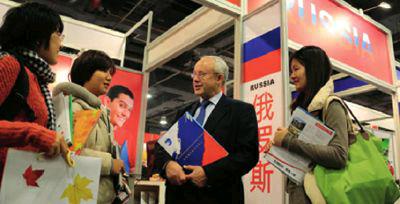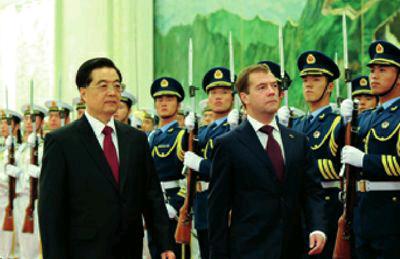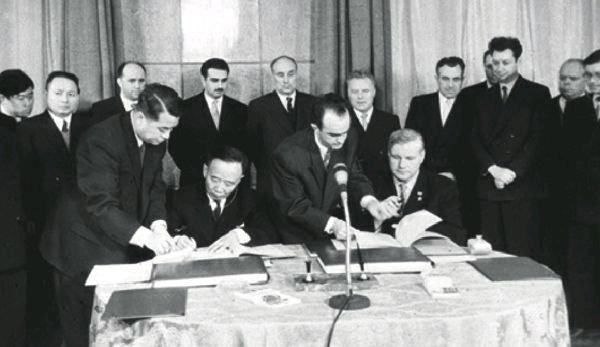An Evolving Partnership
2014-10-29ByLiZiguo
By+Li+Ziguo
In the last 65 years since the establish-ment of their diplomatic relationship, China-Russia (former Soviet Union) relations have undergone several stages— from alliance to confrontation, followed by normalization and a strategic partnership. At present, China-Russia relationship is among the most mature of those between major powers. The two countries actively support one another, meanwhile they are partners—not allies.
A steady pace
The basic trend of the China-Russia relationship is one of constant progression, which is clearly different from the “neither better nor worse” Sino-U.S. relations. Whats more, there have been a series of documents and mechanisms that ensure the general direction of bilateral ties.
Since China and Russia signed a joint statement on the foundation for bilateral ties in 1992, their relationship began a new chapter. In 1996, the two countries established a partnership of strategic coordination. In 2001, China and Russia signed the Treaty of Good-Neighborliness and Friendly Cooperation, laying a strong legal foundation for the two countries to develop their strategic partnership. In February 2013, China and Russia signed a joint statement to deepen their comprehensive strategic partnership of coordination, bringing bilateral relationship to an unprecedented level.
During this period, China and Russia have also solved complex boundary demarcation issues, putting prior border disputes behind them.
Another important factor that guarantees the stable development of the ChinaRussia relationship is the establishment of a set of effective cooperative mechanisms.
The two countries have successively established a mechanism for annual exchange of high-level visits and numerous non-governmental exchange platforms to enhance mutual understanding and settle differences in time.
State heads of the two countries also hold regular meetings on international occasions, such as annual summits of the Shanghai Cooperation Organization (SCO), the BRICS group of emerging economies and the AsiaPacific Economic Cooperation forum. Since Chinese President Xi Jinping took office in March 2013, he has met Russian President Vladimir Putin on nine occasions.
As of 2013, there had been 18 annual meetings between Chinese and Russian prime ministers since their regular meeting mechanism was launched in 1996. The mechanism has become another important platform to outline and coordinate bilateral cooperation in various fields.
After China and Russia conducted their first joint military drill in 2005, the frequency and scale of such exercises have both increased. Over the past two years, they held two joint exercises each year, including a joint anti-terror exercise under the SCO framework. Last year, the Russian Defense Ministry invited President Xi to visit its command center, revealing a strong mutual trust between the two countries.
The scale of people-to-people exchanges between China and Russia in recent years has been unparalleled. Since 2006, the two countries have successfully held a series of events such as the National Year, Year of Languages and Year of Tourism. In 2014 and 2015, the two sides will also hold their Year of Youth Friendly Exchanges. Benefiting from close interactions, there are a growing number of people on both sides who regard each other as friends, which has consolidated public support for good-neighborly friendship between the two countries.
Internal impetus
Currently there is a view that Washington is the major cause for Moscow and Beijings close embrace; if Washington changes its stance, contradictions between Beijing and Moscow will emerge. But this viewpoint has underestimated the role that an internal impetus for cooperation has played for the two countries in deepening their relations. It is common interests that have driven them closer while external factors have merely accelerated the process.
Both countries learnt lessons from the China-Soviet confrontation in the 1960s-80s, which greatly hindered economic development and threatened national security for both nations.
As large emerging economies, China and Russia are complementary to one another. Russia is a big exporter of energy, while China is a major buyer. Russia faces labor shortages and its light industry is congenitally deficient. Meanwhile China is known as the worlds factory. Russia has advantages in aerospace and nuclear energy sectors, while China has advantages in areas such as high-speed railway technology and telecommunications.
As both China and Russia undergo a social and economic transition, they are confronted with similar challenges. Russia must change its resource-based economic development mode, and China also faces the task of sustainable economic transformation and industrial upgrading. While both countries need to deepen economic restructuring, they are also expected to maintain social stability. The two sides need to support each other on these prominent issues.
China and Russia have common aspirations for the democratization of international politics. Both countries are opposed to unilateral actions that push the UN aside. They call for inclusiveness of all civilizations and oppose forced regime changes or altering the institutions of other countries recklessly. They are opposed to attempts to rewrite the history of World War II. All these are both for their interests and the well-being of most international community members. However, China and Russia will not form an alliance as it would possibly lead to new bloc confrontations, bringing more risk of conflicts.
The internal impetuses that galvanize China-Russia ties will exist for a long time. Therefore, even without the U.S. factor, their cooperation will not slow down. And experience has shown that even as Washington raised the concept of “G2” or moved to ease Russian-U.S. relations, China-Russia relations had not been affected.
Increasing mutual trust
China-Russia relations have developed rapidly and smoothly over the past decades, but it doesnt mean there are no differences between the two. Actually, Russia worries China will exert more influence in the former Soviet Union nations as it attaches importance to sphere of influence. Russia fears becoming a raw material appendage of China as well as Chinese immigrants. In addition, Russia still needs time to adjust to a more pow-erful China. As time goes on, Russia is gradually desalting its concerns and becoming more reassured in the current bilateral relationship.
Russia is a unique power. At the moment, Russia is one of the targets of the United States containment policy on a global scale. While the United States is an established power, Russia is regarded as a challenger. But within the sphere of the Commonwealth of the Independent States (CIS) that groups former Soviet Union nations, Russia sees other CIS members as its “backyard.” In this sense, Russia is an established power trying to defend its sphere of influence. The Ukrainian crisis reflects the mindset of Russia. Russia is on the alert for any countries that might compete with it in the region. With the increasing cooperation between China and CIS countries, “China-Russia competition” has surfaced increasingly in the Russian media. Putin also addressed the issue during his presidential campaign.
However, Russia has gradually been aware that most CIS countries pursue multilateral diplomacy and seek independent political, economic and security policies. It has also realized that China, though seen as a “challenger,” respects Russias traditional influence in the region. Actually, the interests of the two countries are compatible. China is a reliable partner of Russia that can help it stabilize the regional situation. During Xis Central Asia trip in September 2013, he made very clear that China will never interfere in the internal affairs of Central Asian countries, nor seek dominance or build a sphere of influence in the region.
Regarding economic cooperation, both China and Russia have a strong wish to strengthen mutually beneficial cooperation and raise their quality and level. Russian people are increasingly aware that without China, the major buyer of Russian resources, Russia might suffer from much slower economic growth. Russians are also gradually changing their attitudes toward Chinese immigrants in Russias Far East region.
A recent survey by Russias Public Opinion Foundation shows that 57 percent of Russian people believe that a powerful China is not a threat to Russia while 19 percent believes it is. As recently as 2009, about 44 percent of Russian people considered China a threat. The new survey shows about 74 percent of Russian people believe China and Russia are friendly partners while just 9 percent disagree.
Chronology of China-Russia Relations
May 21, 2014: The China and Russia Purchase and Sales Contract on East Route Gas Project and a memorandum were signed in Shanghai. The contract will see the east route pipeline start providing China with 38 billion cubic meters of natural gas annually from 2018.
March 2013: The two countries pledged to push forward their comprehensive strategic partnership of coordination into a new phase and ratified the 2013-16 implementation guidelines of the China-Russia Treaty of GoodNeighborliness and Friendly Cooperation.
June 2012: A joint communique on deepening the comprehensive strategic partnership of coordination between China and Russia was signed.
June 2011: The two countries issued a joint statement on a broad range of key international issues.
September 2010: The two sides signed a joint statement on comprehensively deepening strategic partnership of coordination.
September 2009: A program on planning for cooperation between Chinas northeastern region and Russias Far East and Eastern Siberia region (2009-18) was approved.
June 2009: The program for China-Russia investment cooperation planning was approved.
July 21, 2008: The two countries sign an additional protocol on the eastern section of the border between China and Russia in Beijing. The protocol, with a map affiliated, marked the completion of the China-Russia 4,300-km border survey and determination.
June 2005: China and Russia exchanged the ratification of the Supplementary Agreement on the Eastern Section of the China-Russia Boundary Line, ending border problems between the two countries.
October 2004: The guidelines for implementing the Treaty of Good-Neighborliness and Friendly Cooperation were approved.
May 2003: The two countries signed a joint statement in which both sides agreed to develop good-neighborly and friendly relations and a strategic partnership.
July 2001: China and Russia signed the Treaty of Good-Neighborliness and Friendly Cooperation, which has laid a legal foundation for the two countries to develop a strategic partnership.
April 1996: The two countries declared the establishment of a partnership of strategic coordination based on equality and trust and oriented toward the 21st century.
September 1994: The second China-Russia joint statement was signed, announcing the two countries are resolved to establish a constructive partnership with a perspective toward the 21st century.
December 1992: A joint statement on the foundation for bilateral ties was signed, calling for China and Russia to regard each other as “friendly countries.”
December 27, 1991: China and Russia sign a memo to ensure Russia would inherit the diplomatic relations the Soviet Union and China established.
October 2, 1949: China establishes diplomatic relations with the Soviet Union.(compiled by Beijing Review)
